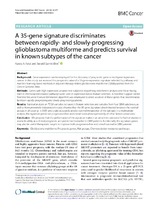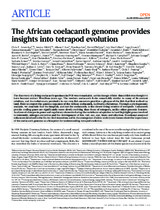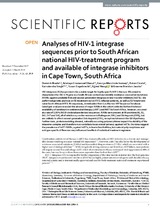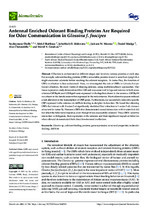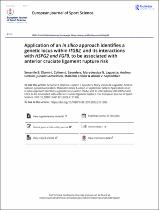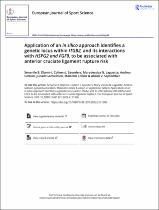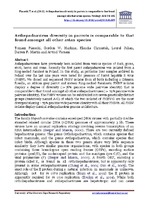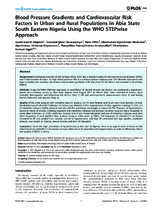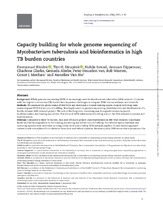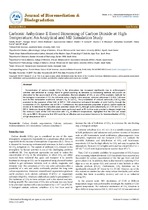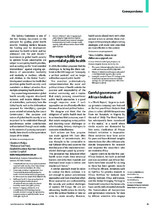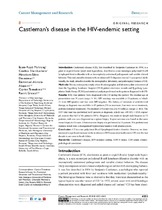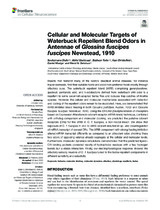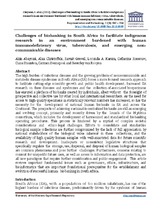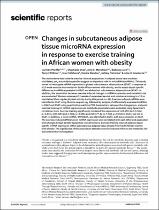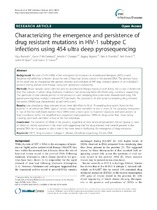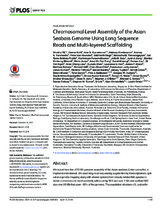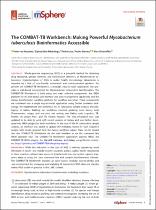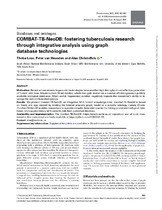Browsing South African National Bioinformatics Institute (SANBI) by Title
Now showing items 1-20 of 135
-
A 35-gene signature discriminates between rapidly- and slowly-progressing glioblastoma multiforme and predicts survival in known subtypes of the cancer
(BioMed Central, 2018)BACKGROUND: Gene expression can be employed for the discovery of prognostic gene or multigene signatures cancer. In this study, we assessed the prognostic value of a 35-gene expression signature selected by pathway ... -
The African Coelecanth genome provides insights into tetrapod evolution
(Macmillan Publishers, 2013)The discovery of a living coelacanth specimen in 1938 was remarkable, as this lineage of lobe-finned fish was thought to have become extinct 70 million years ago. The modern coelacanth looks remarkably similar to many of ... -
Analyses of HIV-1 integrase sequences prior to South African national HIV-treatment program and available of integrase inhibitors in Cape Town, South Africa
(Nature Publishing Group, 2018)HIV-Integrase (IN) has proven to be a viable target for highly specific HIV-1 therapy. We aimed to characterize the HIV-1 IN gene in a South African context and identify resistance-associated mutations (RAMs) against ... -
Antennal enriched odorant binding proteins are required for odor communication in glossina f. Fuscipes
(MPDI, 2021)Olfaction is orchestrated at different stages and involves various proteins at each step. For example, odorant-binding proteins (OBPs) are soluble proteins found in sensillum lymph that might encounter odorants before ... -
Application of an in silico approach identifies a genetic locus within ITGB2, and its interactions with HSPG2 and FGF9, to be associated with anterior cruciate ligament rupture risk
(Taylor and Francis Group, 2023)We developed a Biomedical Knowledge Graph model that is phenotype and biological functionaware through integrating knowledge from multiple domains in a Neo4j, graph database. All known human genes were assessed through ... -
Application of anin silicoapproach identifies a genetic locus withinITGB2,and itsinteractions withHSPG2 and FGF9,to be associated with anterior cruciateligament rupture risk
(Taylor and Francis Group, 2023)We developed a Biomedical Knowledge Graph model that is phenotype and biological function-aware through integrating knowledge from multiple domains in a Neo4j, graph database. Allknown human genes were assessed through the ... -
Avihepadnavirus diversity in parrots is comparable to that found amongst all other avian species
(Elsevier, 2013)Avihepadna viruses have previously been isolated from various species of duck ,goose, stork, heron and crane. Recently the first parrot avihepadna virus was isolated from a Ring-necked Parakeet in Poland. In this study, ... -
Beet leaf (beta vulgaris L.) extract attenuates iron-induced testicular toxicity: Experimental and computational approach
(Elsevier [Commercial Publisher], 2023)The purpose of this study was to investigate the protective effect of Beta vulgaris leaf extract (BVLE) on Fe2+-induced oxidative testicular damage via experimental and computational models. Oxidative testicular damage was ... -
Blood pressure gradients and cardiovascular risk factors in urban and rural populations in Abia State South Eastern Nigeria using the WHO STEPwise approach
(Public Library of Science, 2013)Background: Developing countries of sub-Saharan Africa (SSA) face a double burden of non-communicable diseases (NCDs) and communicable diseases. As high blood pressure (BP) is a common global cardiovascular (CV) disorder ... -
Capacity building for whole genome sequencing of Mycobacterium tuberculosis and bioinformatics in high TB burden countries
(Oxford University Press, 2020)Background Whole-genome sequencing (WGS) is increasingly used for Mycobacterium tuberculosis (Mtb) research. Countries with the highest tuberculosis (TB) burden face important challenges to integrate WGS into surveillance ... -
Carbonic anhydrase II based biosensing of carbon dioxide at high temperature: an analytical and MD simulation study
(OMICS International, 2018)Concentration of carbon dioxide (CO2) in the atmosphere has increased significantly due to anthropogenic activities and attributed as a major factor to global warming. Its detection by biosensing methods will provide ... -
Careful governance of African biobanks
(Elsevier, 2020)The Sydney Statement is one of the first framing documents on the principles for guiding global health security. Framing matters because the funding pool for development assistance for health is finite and has plateaued ... -
Castleman’s disease in the HIV-endemic setting
(Dovepress, 2018)Castleman’s disease (CD), first described by Benjamin Castleman in 1954, is a giant or angiofollicular lymph node hyperplasia, described as a rare monotypic polyclonal B-cell lymphoproliferative disorder with an incompletely ... -
Cellular and molecular targets of waterbuck repellent blend odors in antennae of glossina fuscipes fuscipes newstead, 1910
(Frontiers Media S.A., 2020)Insects that transmit many of the world’s deadliest animal diseases, for instance trypanosomosis, find their suitable hosts and avoid non-preferred hosts mostly through olfactory cues. The waterbuck repellent blend (WRB) ... -
Challenges of biobanking in South Africa to facilitate indigenous research in an environment burdened with human immunodeficiency virus, tuberculosis, and emerging non-communicable diseases
(Mary Ann Liebert, Inc., 2013)The high burden of infectious diseases and the growing problem of noncommunicable and metabolic disease syndromes in South Africa (SA) forces a more focused research approach to facilitate cutting-edge scientific growth ... -
Changes in subcutaneous adipose tissue microRNA expression in response to exercise training in African women with obesity
(Nature Research, 2022)The mechanisms that underlie exercise-induced adaptations in adipose tissue have not been elucidated, yet, accumulating studies suggest an important role for microRNAs (miRNAs). This study aimed to investigate miRNA ... -
Characterizing the emergence and persistence of drug resistant mutations in HIV-1 subtype C infections using 454 ultra deep pyrosequencing
(BioMed Central -The Open Access Publisher, 2013)BACKGROUND: The role of HIV-1 RNA in the emergence of resistance to antiretroviral therapies (ARTs) is well documented while less is known about the role of historical viruses stored in the proviral DNA. The primary ... -
Chromosomal-level assembly of the Asian seabass genome using long sequence reads and multi-layered scaffolding
(Public Library of Science, 2016)We report here the ~670 Mb genome assembly of the Asian seabass (Lates calcarifer), a tropical marine teleost. We used long-read sequencing augmented by transcriptomics, optical and genetic mapping along with shared ... -
The combat-tb workbench: Making powerful Mycobacterium tuberculosis bioinformatics accessible
(American Society for Microbiology, 2022)Whole-genome sequencing (WGS) is a powerful method for detecting drug resistance, genetic diversity, and transmission dynamics of Mycobacterium tuberculosis. Implementation of WGS in public health microbiology laboratories ... -
COMBAT-TB-NeoDB: Fostering tuberculosis research through integrative analysis using graph database technologies
(Oxford University Press, 2020)Tuberculosis (TB) is a significant global health threat, with onethird of the population infected with its causative agent Mycobacterium tuberculosis (M.tb). Globally, researchers have been responding with a plethora of ...

